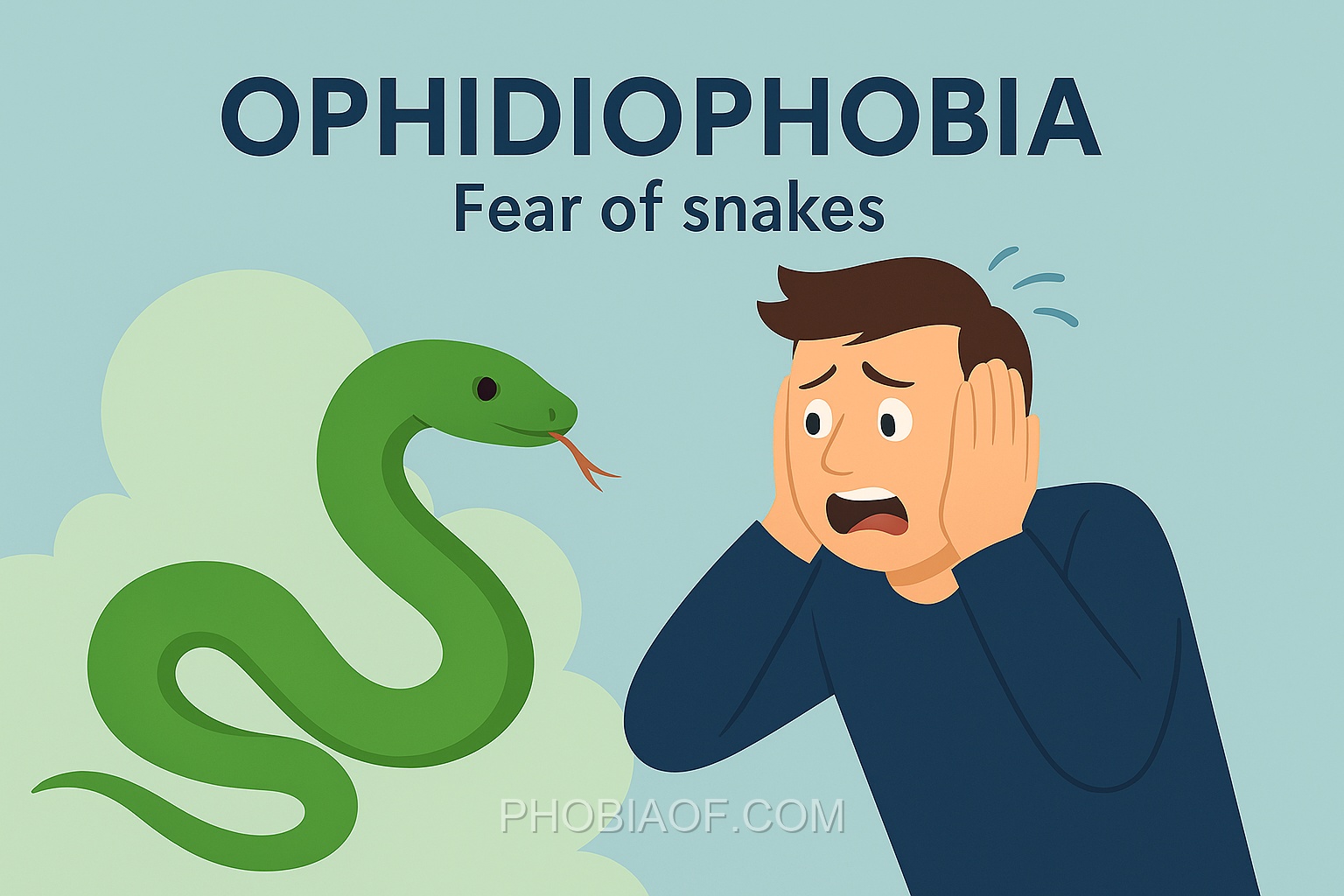Have you ever felt a sudden rush of panic at the mere sight of a snake, even if it was just on television? If so, you might be familiar with Ophidiophobia, a common and intense fear of snakes.
Ophidiophobia is derived from the Greek words “ophis,” meaning snake, and “phobos,” meaning fear. It’s more than just a mild discomfort; this phobia can trigger significant anxiety and distress.
For those who experience it, Ophidiophobia can manifest in various ways, impacting daily life. Here are some common effects:
- Avoidance of places where snakes might be present, such as parks or hiking trails.
- Excessive worry or panic when encountering a snake, even if it’s in a safe environment like a zoo.
- Physical symptoms such as sweating, trembling, or a racing heart when thinking about or seeing snakes.
Understanding Ophidiophobia is the first step towards managing it, and it’s important to approach this fear with compassion and empathy. Whether you’re personally affected or simply curious, recognizing the genuine distress it can cause is essential for fostering awareness and support.
Causes of Ophidiophobia
Ophidiophobia, the fear of snakes, is a common phobia that can stem from various causes. Understanding these causes can provide insight into why this fear develops and persists in some individuals. Below are some potential causes of ophidiophobia:
- Genetic Predisposition: Some research suggests that phobias, including ophidiophobia, may have a genetic component. If a close family member has a fear of snakes, an individual might be more likely to develop a similar fear due to inherited genetic traits.
- Traumatic Experiences: A direct encounter with a snake, particularly if it was frightening or harmful, can lead to ophidiophobia. For instance, being bitten or witnessing someone being bitten can instill a lasting fear.
- Learned Behavior from Others: Observing others who exhibit a fear of snakes can influence one’s own feelings towards them. If a parent or influential figure shows a strong aversion to snakes, it can be learned and internalized as a fear by younger individuals.
- Psychological Factors: General anxiety and other psychological issues can contribute to the development of specific phobias. People with higher levels of anxiety might be more prone to developing fears, including ophidiophobia.
- Environmental Factors: Cultural and environmental contexts can play a role. In regions where snakes are common and potentially dangerous, people might develop a fear as a survival mechanism, passed down through generations.
Interestingly, some theories propose that ophidiophobia might have an evolutionary basis. Snakes have historically been predators or threats to humans, and an innate fear could have developed as a protective measure. This theory suggests that people who feared snakes might have been more likely to survive and pass on their genes.
Understanding these causes highlights the complexity of phobias and the interplay of genetic, psychological, and environmental factors. Addressing ophidiophobia typically involves therapeutic approaches, such as cognitive-behavioral therapy, to help individuals manage and overcome their fear.
Symptoms of Ophidiophobia
Ophidiophobia, the intense fear or anxiety concerning snakes, manifests in various physical, emotional, and behavioral symptoms. Understanding these symptoms can help individuals identify the phobia in themselves or others. Here are some common signs:
- Intense Fear or Anxiety: An overwhelming sense of dread or panic at the sight or even thought of snakes.
- Panic Attacks: Sudden episodes of intense fear that may include difficulty breathing, chest pain, and dizziness.
- Sweating: Excessive perspiration when confronted with snakes or snake-related stimuli.
- Rapid Heartbeat: A noticeable increase in heart rate when thinking about or encountering snakes.
- Shaking or Trembling: Physical shaking or trembling, especially when near a snake.
- Nausea: Feeling nauseous or having an upset stomach at the thought or sight of snakes.
- Avoidance of Triggers: Actively avoiding places or situations where snakes might be present, such as zoos or nature trails.
- Overwhelming Dread: Experiencing intense fear and apprehension about encountering snakes in daily life.
- Inability to Function: Difficulty concentrating or functioning normally due to preoccupation with the fear of snakes.
If severe, these symptoms can significantly interfere with daily life, limiting activities and causing distress in professional, social, and personal settings.
Treatment for Fear of Snakes
Ophidiophobia, or the fear of snakes, can be challenging, but it is important to know that this phobia can be treated and managed over time. With the right approach and support, individuals can overcome their fear and regain control over their lives. Below are some effective treatment options and coping strategies to help you on your journey.
Treatment Options
- Exposure Therapy: This is a gradual process where individuals are slowly exposed to snakes in a controlled and safe environment. The goal is to desensitize the person to their fear by progressively facing it, starting with images or videos and eventually moving to real-life encounters. This therapy helps build confidence and reduce anxiety associated with snakes.
- Cognitive-Behavioral Therapy (CBT): CBT focuses on changing the negative thought patterns that contribute to the fear of snakes. By addressing these thoughts and replacing them with more rational and balanced perspectives, individuals can better manage their fear responses.
- Counseling: Talking to a mental health professional can provide support and guidance. Counseling offers a space to explore the underlying causes of the phobia and develop strategies to cope with anxiety.
Self-Help Coping Techniques
- Relaxation Exercises: Techniques such as deep breathing, progressive muscle relaxation, and visualization can help calm the mind and reduce anxiety levels. Practicing these exercises regularly can make it easier to manage fear when it arises.
- Meditation: Mindfulness meditation can increase awareness of the present moment and help individuals distance themselves from the intense emotions associated with their fear.
- Support Groups: Connecting with others who share similar fears can be incredibly reassuring. Support groups provide a platform to share experiences, gain insights, and receive encouragement from peers.
While therapy and coping skills are the focus, medication such as anti-anxiety meds might be prescribed in severe cases to help manage symptoms. However, it is crucial to work closely with a healthcare provider to determine the best course of action.
Encouragement and Next Steps
Remember, overcoming ophidiophobia is a journey, and it is okay to seek help. If your fear of snakes is interfering with your daily life, consider reaching out to a mental health professional. With time, patience, and the right support, you can conquer your fear and lead a more fulfilling life.
Conclusion
Understanding the causes and symptoms of ophidiophobia can be a powerful first step in addressing this common fear. By recognizing the triggers and manifestations of this phobia, individuals can begin to take proactive steps toward managing and potentially overcoming their fear of snakes. Knowledge empowers, and with it, the journey to coping with ophidiophobia becomes less daunting.
It is important to remember that many people successfully manage or overcome their phobias with time and the right assistance. Seeking support from mental health professionals or discussing concerns with a doctor can be highly beneficial. Therapeutic interventions, such as cognitive-behavioral therapy, have proven effective in helping individuals confront and reduce their fears.
Take heart in knowing that you are not alone, and help is available. Embrace the possibility of change and the opportunity to live a life less influenced by fear. Consider reaching out for support today, and take the first step toward a more empowered and fearless future.






